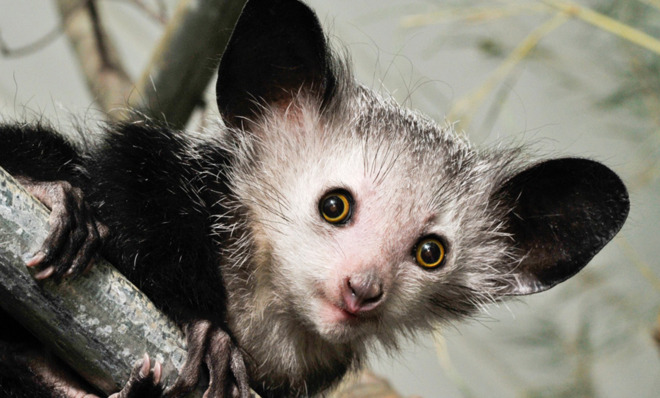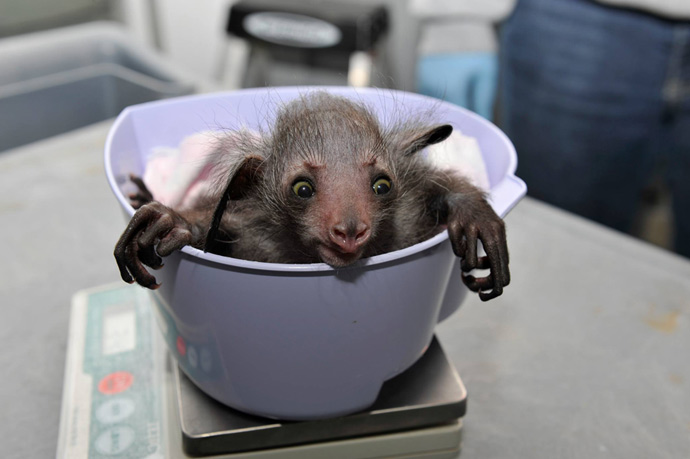What I learned from hanging out with lemurs
Giving a pregnant lemur a sonogram is a months-long ordeal. And you'll need Craisins and applesauce.

Ardrey the aye-aye was showing signs of pregnancy. That means nest-building, the presence of a sperm plug, or simply not womping on any nearby males. Aye-ayes are lemurs, after all, and lemurs tend to be female dominant — which means male lemurs spend a lot of the day trying not to get the crap kicked out of them.
Because Ardrey is one of just 50 aye-ayes in the entire world living in captivity, her handlers at the Duke Lemur Center were anxious to give her a prenatal exam. Aye-ayes are considered endangered by the International Union for Conservation of Nature, and sustaining a captive population could one day be crucial to the species' survival.
"That makes every single one of these individuals born and unborn very valuable," said Chris Smith, an education specialist with the center. Located outside Raleigh, North Carolina, the DLC is a 70-acre facility (that I was lucky enough to visit earlier this year) that houses the largest and most diverse lemur population outside of Madagascar.
Subscribe to The Week
Escape your echo chamber. Get the facts behind the news, plus analysis from multiple perspectives.

Sign up for The Week's Free Newsletters
From our morning news briefing to a weekly Good News Newsletter, get the best of The Week delivered directly to your inbox.
From our morning news briefing to a weekly Good News Newsletter, get the best of The Week delivered directly to your inbox.
But you can't just schedule a lemur sonogram at the local OB/GYN. For one, aye-ayes are notoriously manic. And two: "Aye-ayes have big, sharp teeth that we're all afraid of," said Smith. Even under normal conditions, if the aye-ayes aren't kept constantly stimulated, they'll gnaw through the cinderblock walls and floors of their enclosure.
In the wild, the aye-aye uses those rodent-like chompers to tear through tree trunks and expose prey. Aye-ayes also have a long, bony, go-go-gadget finger that can rotate a full 360 degrees and terminates in a claw, which it uses to fish for grubs deep within the bark of trees. It's both the creepiest and coolest thing you'll watch today.
Luckily, this bitey disposition can be overcome with training. Like most lemurs, the aye-ayes are highly adaptable and respond well to reward-based activities. Rather than try to catch the animals with nets and hold them down every time they need to administer medicine or weigh them — an activity that's dangerous to both animal and human — the DLC prefers to coax the lemurs into compliance with a steady dose of dried cranberries.
"Craisins are like lemur crack," said Smith.
A free daily email with the biggest news stories of the day – and the best features from TheWeek.com
The DLC has even taught the little primates to "paint" by throwing a bunch of Craisins onto a mat full of non-toxic, water-soluble paint globs. The lemurs lose their minds over the treats and create some modern art in the process. (Note to OceanSpray: If you're looking to sponsor a good cause…)
With enough repetition and Craisins, researchers have found lemurs can be trained to perform numerous behaviors outside of their natural repertoire. After all, the DLC is no petting zoo. It was founded in 1966 to better understand prosimian primates, and while the mission has since shifted a bit toward outreach and conservation, the center maintains a focus on research. Projects range from biomechanics and biology to cognition and aging.

But conditioning animals takes time. So months before Ardrey ever got pregnant, the handlers started teaching her to trade certain behaviors for a snack. Every time Ardrey would hang calmly in front of them, the handlers gave her a Craisin. Then they added a little belly rub to the hanging behavior. In this way, the lemur builds up a positive association between the desired behavior and a sour-sweet snippet of dried fruit.
After several months of persistence, Ardrey had learned almost all the behaviors necessary for a sonogram. In the meantime, she'd also been allowed to conceive. As a matter of maintaining genetic diversity, every pregnancy in the DLC is planned. Lemurs not scheduled to procreate are either given injections of Depo-Provera or intrauterine devices (IUDs). (You might be on the same birth control as a lemur!)
As a final test of Ardrey's training, the keepers decided to try the whole behavior repertoire with an actual sonogram wand and the tiniest bit of ultrasound gel, since any new stimulus has to be instituted gradually. But as soon as the jelly touched her belly, Ardrey bolted for the highest branches of her enclosure. Training session over.
To make sure it wasn't a fluke, the keepers tried several more times over the course of the next few days, but every attempt ended in failure.
"We don't know if it was the texture or smell," said Smith, "but it became clear that the ultrasound gel wasn't going to happen."
Unfortunately, the gel is necessary to the sonogram process because ultrasound waves can't travel well through the air. But that cold blue jelly isn't the only thing that can act as a conductive medium between wand and womb.
That's when one of the keepers had an idea and went rummaging through the DLC fridge. She came back with a jar of applesauce.
This time, Ardrey performed swimmingly. Not only did she get her treats for performing all the behaviors properly, but she also got to lick all the applesauce off her belly while all those silly humans did whatever it was they were doing.
In the end, the applesauce allowed the DLC to confirm that the aye-aye was in fact pregnant and that both mother and baby were healthy. A few months later, Ardrey gave birth to baby Elphaba, named after the protagonist from Wicked.
So, what's the moral of this story? Conserving endangered species is hard work that requires perseverance, patience, and creative thinking.
Also, if you hate the blue gunk they use at your prenatal visits, try bringing in a jar of Mott's. Even if they get all "health code" on you and refuse to use it, at least you'll have something to munch on during the hour-and-a-half-long wait.
Jason Bittel serves up science for picky eaters on his website, BittelMeThis.com. He writes frequently for Slate and OnEarth. And he's probably suffering from poison ivy as you read this.
-
 The app tackling porn addiction
The app tackling porn addictionUnder the Radar Blending behavioural science with cutting-edge technology, Quittr is part of a growing abstinence movement among men focused on self-improvement
-
 Magazine solutions - August 29, 2025
Magazine solutions - August 29, 2025Puzzles and Quizzes Issue - August 29, 2025
-
 Magazine printables - August 29, 2025
Magazine printables - August 29, 2025Puzzles and Quizzes Issue - August 29, 2025
